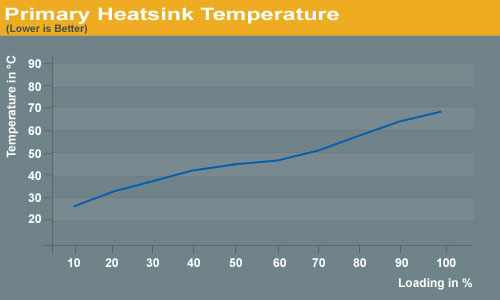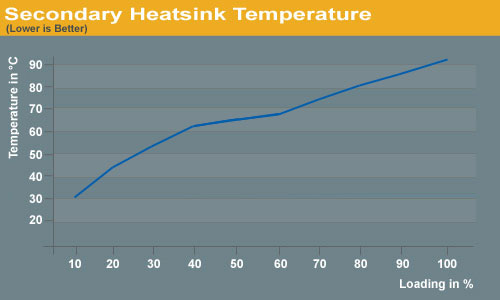AnandTech Power Supply Test Methodology
by Christoph Katzer on July 12, 2007 12:00 AM EST- Posted in
- Cases/Cooling/PSUs
Temperature
The ambient temperature around the power supply will constantly grow with the time of the test. It will be placed in the same set of conditions it will experience in a real system, where the temperature rises over time. We will start at a room temperature of 77°F (25°C) and constantly measure the exhaust temperature of the power supply and the installed heatsinks inside the PSU. This will tell us how well the power supply can dissipate the produced heat.

Sample Heatsink Temperature

Sample Heatsink Temperature
It is especially true that as the ambient temperature increases it becomes more difficult for the components of the power supply to deliver the rated specifications. A dropping DC voltage is one potential side effect of this. With increasing heat the lifespan of the PSU and its components will drop tremendously as well. When the power supply is working on our test stand for several hours the heat around it will increase up to 122°F (50°C). At that point it will be running at full load under the most strenuous circumstances possible.
We expect many candidates to fail our full load testing since normal power supplies are all rated just at room temperature of 77°F (25°C). We know we will put power supplies in a very difficult position, but those which pass will be truly worth buying. After all, what's the point of spending a lot of money on a high quality power supply if it can't handle rigorous test scenarios?
The ambient temperature around the power supply will constantly grow with the time of the test. It will be placed in the same set of conditions it will experience in a real system, where the temperature rises over time. We will start at a room temperature of 77°F (25°C) and constantly measure the exhaust temperature of the power supply and the installed heatsinks inside the PSU. This will tell us how well the power supply can dissipate the produced heat.

Sample Heatsink Temperature

Sample Heatsink Temperature
It is especially true that as the ambient temperature increases it becomes more difficult for the components of the power supply to deliver the rated specifications. A dropping DC voltage is one potential side effect of this. With increasing heat the lifespan of the PSU and its components will drop tremendously as well. When the power supply is working on our test stand for several hours the heat around it will increase up to 122°F (50°C). At that point it will be running at full load under the most strenuous circumstances possible.
We expect many candidates to fail our full load testing since normal power supplies are all rated just at room temperature of 77°F (25°C). We know we will put power supplies in a very difficult position, but those which pass will be truly worth buying. After all, what's the point of spending a lot of money on a high quality power supply if it can't handle rigorous test scenarios?










49 Comments
View All Comments
jtleon - Thursday, July 12, 2007 - link
For the most accurate sound level testing, the air temperature around the microphone and the power supply is very VERY important. The microphone must reach steady state temperature and be calibrated at that temperature. The air temperature in the anechoic chamber must be maintained as constant, otherwise the microphone measurements will be off as much as 3-4dB in my experience for a temp delta of only 15°F.Also, no one is interested in the noise PS generates inside the PC case, rather the noise emitted to the exterior of the PC. And beware the air temperature inside the PC is much much higher than the interior PC air temperature. I don't see how your test approach will address these critical issues.
jtleon - Thursday, July 12, 2007 - link
Ooops...I meant to say,And beware the air temperature inside the PC is much much higher than the exterior PC air temperature.
LTG - Thursday, July 12, 2007 - link
This is exactly the high bar I expected from AT and I'm really glad to see you guys do it right.I've always felt that other review sites were missing a lot in this area.
LTG
lsman - Thursday, July 12, 2007 - link
Thanks, looking forward for the reviews. Please don't let it delay (or MIA) like those m-atx or motherboard.It will be more interesting than all those HSF reviews...
Kensei - Thursday, July 12, 2007 - link
A small nitpick... Japan is also 120VAC (actually 100) and uses flat blade plugs. I live in Japan and everthing I brought here from the US works fine. See
http://www.kropla.com/electric2.htm
Martimus - Thursday, July 12, 2007 - link
I used to test power sources and signal sources for variaous automotive components, and I am wondering why you are using a multimeter to measure the output instead of an oscilliscope. You can measure both current and voltage and actually capture the waveform to measure the ripple voltage with a good o-scope. When it comes to analyzing signals, the oscilliscope is a far more valuable tool than a multimeter.just my 2 cents.
acronos - Thursday, July 12, 2007 - link
I'm interested in how the power supply handles electrical noise from the power company. I know most of us have battery backups, but the power supply should do power line noise suppression too. In my area we have brownouts (low voltage), spikes (lightning strikes nearby), and just general noise. I also use computers in a manufacturing environment, which causes significant noise on the power lines.LoneWolf15 - Thursday, July 12, 2007 - link
What you want then, are line conditioners, or a UPS with line-conditioning capability.The most a power supply provides is Active Power Factor Correction, which will clean up things a little, but that's not a subsitute for a UPS with line conditioning, which will solve your issues with brownouts and spikes. This kind of gear would be expensive and bulky to try and add into a power supply; I don't see it happening any time soon.
LoneWolf15 - Thursday, July 12, 2007 - link
Clarification: Not every PSU has Active PFC --a better explanation can be found here:http://www.dansdata.com/gz028.htm">http://www.dansdata.com/gz028.htm
sprockkets - Saturday, July 14, 2007 - link
Yeah very good explanation. Another way of looking at it is I found a site sometime ago that showed the pfc as a 90 triangle to show the relationship.I'm looking for a good test of those fanless power supplies, but again, without a fan it does put a damper in the cooling.